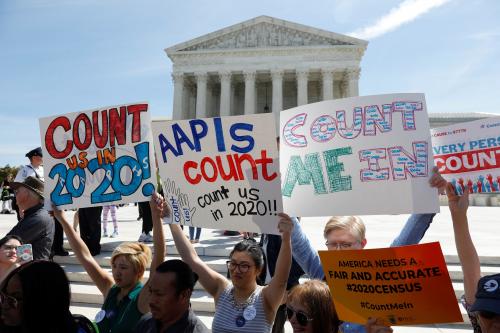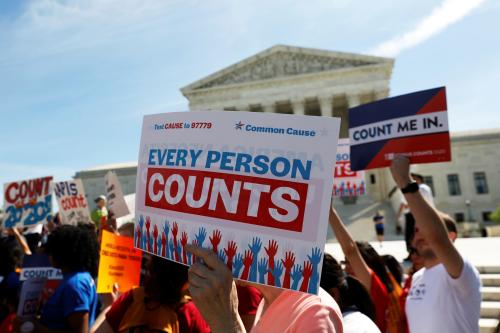Last week, the Trump administration declared defeat in its efforts to put the controversial citizenship question on the 2020 census. This was confirmed in July 2nd statements by the Department of Justice to courts and by Commerce Secretary Wilbur Ross’s instructions to begin printing census forms without this question. These actions were viewed as a capitulation of the Trump administration to a June 27th Supreme Court ruling, which stated that the administration’s rationale for this question was “contrived” and needed further justification, as well as a result of the time-sensitive pressure to begin printing over one billion forms needed by census day next April. It was hailed by civil rights groups and others as a victory with many winners.
Yet, countering the actions of his own administration, President Trump soon began tweeting that he would “do what whatever is necessary” and was “absolutely moving forward” to put the citizenship question on the census, perhaps with a legally questionable executive order. New DOJ lawyers, replacing the previous ones, have been ordered to make this happen. While the odds of success are seen to be small by some, Trump’s persistence on this issue is unusual even by his standards.
There are several reasons for this. First, it is consistent with the anti-immigrant stance , popular with his base, that suggests it is important that the U.S. census distinguishes citizens from foreign born, possibly undocumented residents. Second, by most estimates, a citizen question would be likely to lead to an undercount of large numbers of residents heavily concentrated in urban, foreign born, Hispanic, and Asian communities—those that typically vote for Democrats. But foremost, in the eyes of many of his political strategists, the addition of a citizenship question could pave the way for the eventual use of the citizen voting age population (CVAP) in redistricting, an outcome that could give the current Republican base enduring advantages well beyond Trump’s presidency. Trump himself confirmed that this is the top reason for his strong support for the citizenship question, stating: “Number 1, you need it for Congress—you need it for Congress for districting.”
By including the citizenship question on the census, states could be empowered to use the CVAP rather than the total population as the basis of drawing legislative districts, be they for Congress or state legislature seats. If citizen status information is available for everyone that fills out the census form, the Census Bureau would produce data for small geographies that contains age, sex, race and citizenship data that can be used for redistricting purposes. This would tempt Republican leaning states to use voting age citizens as the basis for drawing legislative maps, increasing the power of their base.
By how much would this change the nature of districts? It would make them substantially whiter as well as older and less urban.
By how much would this change the nature of districts? It would make them substantially whiter as well as older and less urban. This is not only because the CVAP population leaves out noncitizens. It is primarily because it leaves out the racially diverse under age 18 not-old-enough-to-vote population. The most recent American Community Survey data for 2017 makes this plain. While the national population is 61% white, the citizen voting age population is 68% white. A main reason for this is that the under age 18 population is just 51% white.

The creation of districts on the basis of the CVAP would drastically reduce the representation of the highly diverse child population—and, by extension, the education, health, and social service needs of their young families—by giving their representatives a lesser voice in considering legislation.
This can especially short change minority and young people’s interests in states like Texas. Between 2010 and 2017, Texas, whose youth population is less than one-third white and over half Hispanic, led the nation in gains of children under 18. If Texas drew legislative boundaries based on the citizen voting age population, which is 51% white and 30% Hispanic, young Hispanic families would not get their due in either state legislatures or Congress. (Statistics for all states are shown in downloadable Table A.)

For Texas, many other states, and the U.S. as a whole, the 2017 racial/ethnic makeup of their voting age populations look close to their total populations from the 2000 census—suggesting a nearly two decade lag between the demographic profiles of residents and their representatives. Projections conducted by the States of Change project show that their citizen voting age populations will not look like their 2017 total populations until at least 2030.
The switch from “one-person/one vote” to “one voting age citizen/one vote” as a basis for drawing legislative districts is not a guaranteed outcome of this administration’s ploy to insert citizenship data into the redistricting process. But it is possible. In 2016, when the issue was brought to the Supreme Court in Evenwell v. Abbot, the Court ruled that states were allowed to use their total populations to determine districts but it did not rule on the use of eligible voters for this purpose. It is because the door is still left open on the latter that proponents of a citizenship question persuaded the administration to add it to the 2020 census. Among those proponents is the deceased Republican redistricting strategist Thomas Hofeller, whose recently discovered correspondence with administration officials argued that adding the citizenship question would be advantageous to “Republicans and non-Hispanic whites”. (His writings are evidence in a just re-opened lawsuit against the administration which asserts that the citizenship question was added to discriminate against immigrant communities of color.)
Adding the citizenship question to the 2020 census will have many harmful effects on growing segments of America’s population. It is estimated that the addition of this question would keep up to nine million people from participating in the census, skewed heavily toward Hispanics, Asians, urban residents, and the young. They will miss their fair share of some $900 billion of federal and state resources that are allocated based on census counts.
But even more important might be its longer-term impact in distorting legislative districts to a “one voting age citizen/ one vote” framework which will even further dilute the representation of younger, diverse, and denser populations that comprise larger parts of the nation’s total population than its voting aged population. As part of his continuing effort to “make America white again,” Trump and his party will be shortchanging this population’s long-term interests while also shortchanging the nation’s future.
The Brookings Institution is committed to quality, independence, and impact.
We are supported by a diverse array of funders. In line with our values and policies, each Brookings publication represents the sole views of its author(s).






Commentary
Trump puts the census citizenship question back in play
Redistricting to favor Republican and white voters is the top reason
July 9, 2019